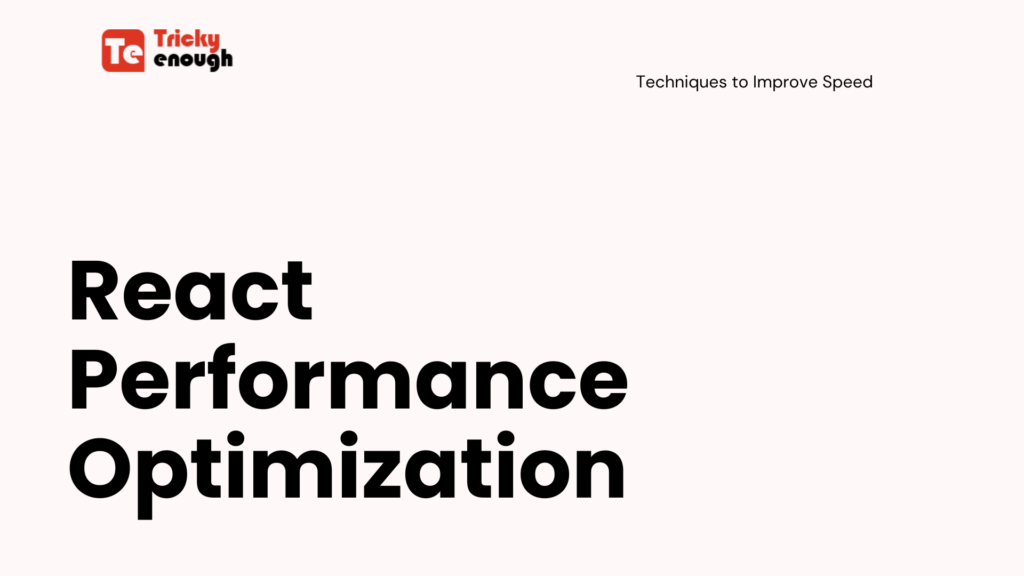Ajaypal Sharma
I love to share about technology and new things I learn.
React is a popular JavaScript library for creating user interfaces, especially single-page applications (SPAs). While React simplifies the creation of interactive and...

Image Credits: canva
React is a popular JavaScript library for creating user interfaces, especially single-page applications (SPAs). While React simplifies the creation of interactive and dynamic online apps, speed optimisation becomes increasingly important as the application’s complexity grows. Without sufficient optimisation, performance might suffer, leading to slow rendering, longer load times, and a worse user experience. In this article, we’ll look at different approaches for React performance optimisation to ensure your apps operate smoothly and efficiently.
React provides several built-in tools to help developers monitor and improve performance:
Unnecessary re-rendering of a component can harm performance, especially if the component is complex or requires intensive computations. React offers multiple ways to manage re-renders:
shouldComponentUpdate (Class Components): This lifecycle method returns a boolean result, allowing you to determine when a component should re-render. If you return false, the component will not render again.
class MyComponent extends React.Component {
shouldComponentUpdate(nextProps, nextState) {
return nextProps.someValue !== this.props.someValue;
}
}
React.memo (Functional Components): React.memo is a higher-order component that covers a functional component and avoids redundant re-renders if the component’s props remain unchanged.
const MyComponent = React.memo(function MyComponent(props) {
return <div>{props.someValue}</div>;
});
Lazy loading is the technique of loading only the application’s necessary components or chunks as needed. This can dramatically lower your application’s initial load time while improving its perceived performance.
React’s React.lazy and Suspense allow you to load components dynamically:
const MyComponent = React.lazy(() => import(‘./MyComponent’));
function App() {
return (
<Suspense fallback={<div>Loading…</div>}>
<MyComponent />
</Suspense>
);
}
By using lazy loading, you may divide your program into smaller bundles that are loaded only when necessary, resulting in faster initial load times.
Rendering huge lists or grids might be a performance issue if each item requires a complicated render. React Virtualisation is a library that allows you to render only the objects visible in the viewport, minimising the number of DOM elements while improving speed.
Popular libraries like react-window and react-virtualised provide optimised solutions for rendering large datasets in a virtualised list.
const MyList = () => (
<List
height={400}
itemCount={1000}
itemSize={35}
width={300}
>
{({ index, style }) => <div style={style}>Item {index}</div>}
</List>
);
Immutable data structures help to avoid unwanted re-renders by making it easier to detect changes. Using immutable data allows React to easily compare the old and new states, optimising the re-rendering process.
To generate immutable data structures in JavaScript, utilise libraries such as Immutable.js or Immer. This approach allows React to identify changes more effectively and reduces the number of unwanted re-renders.
The React Context API enables you to communicate state between components without having to send props explicitly. However, if not utilised appropriately, it might cause performance concerns because every time the context value changes, all components must re-render.
To optimise context performance:
If your application relies extensively on user inputs (such as search or form fields), debounce or throttle the user’s activities to avoid unnecessary re-renders or API requests.
Libraries like lodash provide convenient methods for debouncing and throttling.
import { debounce } from ‘lodash’;
const handleChange = debounce((e) => {
console.log(e.target.value);
}, 300);
<input onChange={handleChange} />
If your application requires extensive computations, try outsourcing them to a Web Worker. Web Workers enable you to run JavaScript code in a separate thread, keeping the UI thread from becoming stopped and increasing the overall responsiveness of your application.
Large images and assets can significantly slow down your React application. To optimise images:
Server-side rendering (SSR) and static site generation (SSG) are approaches for generating your React app on a server rather than a client. This can enhance your application’s performance, particularly on initial load, as well as its SEO.
Frameworks like Next.js include built-in support for SSR and SSG, making implementation easier.
React performance optimisation is a continuous process that necessitates a variety of strategies and technologies. Understanding and adopting these optimisation strategies—such as memoising components, lazy loading, virtual lists, and server-side rendering—can drastically enhance the performance of your React application, providing users with a faster and smoother experience. Remember that performance is an ongoing problem, so profile your application frequently, identify bottlenecks, and implement relevant optimisation approaches.
Suggested:
10 Mistakes to Avoid in React Native App Development.